Discover the 10 best resource management software platforms — ranked by key features, pricing and more — to choose the best one for your business.
Resource management software helps businesses of all sizes track and optimize resources such as finances, personnel, equipment and materials. This can help businesses manage their operations better, improve productivity and increase profits. If you’re currently managing your resources in an Excel spreadsheet, upgrading to resource management software can take your business to the next level.
We’ve rounded up 10 of the best resource management software options and broken down their pricing plans, features pros and cons to help you make a decision.
Best resource management software comparison
| Software | Best for | Starting price | Capacity Planning | Resource scheduling | Integration with third-party tools | Free trial |
|---|---|---|---|---|---|---|
| Resource Guru | Affordability | $4.16 per person per, month, annually | Yes | Yes | Yes, 1,500+ | 30-day free trial |
| Mosaic | Intuitive resource management | Custom price | Yes | Yes | Yes | 30-day free trial |
| Kantata | All-in-one resource management tool | Custom price | Yes | Yes | Yes | Yes |
| Bitrix24 | Small businesses | Free | Yes | Yes | Yes | 30-day free trial |
| Hub Planner | Distributed and WFH teams | $7 per resource per month | Yes | Yes | Yes | 30-day free trial |
| Float | Agencies | $6 per user per month | Yes | Yes | Yes | 30-day free trial |
| ClickUp | Enterprise | Free | Yes | Yes | Yes, 1,000+ | Yes |
| Smartsheet | Workflow automation | Free | Yes | Yes | Yes | Yes |
| monday work management | Flexibility and customization | Free | Yes | Yes | Yes | 14-day free trial |
| Wrike | Midsize to large enterprise | Free | Yes | Yes | Yes, 400+ | 14-day free trial |
Resource Guru: Best for affordability
If your resource management needs mostly revolve around scheduling, then check out Resource Guru, which is designed to help with exactly that. This cloud-based resource planner software helps companies manage and schedule resources, such as not only employees but also meeting rooms, equipment and other assets (Figure A). Features include real-time reporting, calendar synchronization, time tracking via integration and customizable views. Pricing plans are also extremely affordable, starting at $4.16 per person per month.

Pricing
- Grasshopper Plan: $4.16 per person per month, plus $2.08 per non-human resource, billed annually; or $5 per person per month, plus $2.50 per non-human resource, billed monthly.
- Blackbelt Plan: $6.65 per person per month, plus $3.33 per non-human resource, billed annually; or $8 per person per month, plus $4 per non-human resource, billed monthly.
- Master Plan: $10 per person per month, plus $5 per non-human resource, billed annually; or $12 per person per month, plus $6 per non-human resource, billed monthly.
Standout features
- Resource scheduling: Drag-and-drop functionality makes it easy to block off time, split shifts, duplicate entries and more.
- Leave management: Resource Guru can be used to track employee leave or time off such as parental leave, public holidays, sick leave, compassionate leave and personal vacation.
- Meeting room booking system: Use the platform to book a meeting room and avoid double booking for important meetings.
Top integrations
- Google Calendar.
- Outlook.
- Zapier.
Pros
- 30-day free trial.
- Entry-level plan offers a lot of functionality.
- Unlimited projects and clients on all plans.
- Calendar sync available.
Cons
- Data import is only available with the Master plan.
- The two cheapest plans lack phone support.
- Very few native integrations.
Why we chose Resource Guru
Resource Guru is specifically focused on resource scheduling and management, and it excels at this particular goal — though it may not be robust enough for other types of effective resource management. Its pricing plans are also extremely affordable, meaning that even small businesses on a budget can try this resource tracking tool.
Mosaic: Best for intuitive resource management
Mosaic is an AI-powered resource management platform that helps organizations plan, schedule and optimize resources. The visual, intuitive design and drag-and-drop interface make it easy to take advantage of the tool’s powerful features (Figure B). The resource allocation tools harness the power of AI to help you build a team with specific skill sets in just minutes. Mosaic also comes pre-loaded with reporting templates and graphs that are specifically designed for resource management needs.
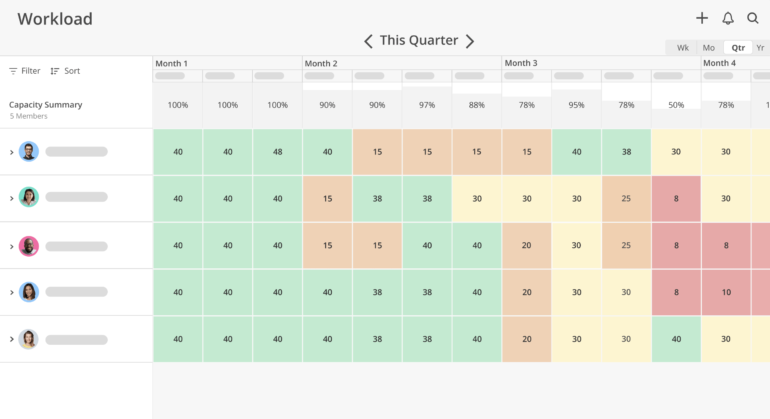
Pricing
Mosaic offers three pricing plans:
- Team plan.
- Business plan.
- Enterprise plan.
However, they don’t disclose pricing information for them. You must contact the sales team for a custom pricing quote.
Mosaic also charges small monthly fees for certain add-ons:
- Additional guests are $11.99 per person per month.
- Project contractors are $3.99 per person per month.
- Some additional charges may apply for certain integrations as well.
Standout features
- AI features: Artificial intelligence learns about your organization over time to provide forecasts and suggestions for improvements.
- Skills assessment: Helps you assess strengths, weaknesses and opportunities for all employees to promote a more strategic approach to staffing.
- Financial management: Integrate with financial software to create project fee budgets and track spending over time.
Top integrations
- Slack.
- Microsoft Teams.
- Xero.
- Salesforce.
- Jira.
- Google Calendar.
- Asana.
Pros
- Workload, utilization and budget reporting capabilities.
- Drag-and-drop interface design.
- Timesheets are easy to fill out.
- Lower learning curve.
Cons
- Pricing is not transparent.
- Limited integration capabilities.
- System can sometimes run slow or glitch.
Why we chose Mosaic
In the resource tracking software market, Mosaic stands out for its intuitive design, drag-and-drop interface and low learning curve for beginners. It also doesn’t sacrifice functionality, packing the software full of resource-specific features that will meet many companies’ needs.
Kantata: Best for an all-in-one resource management tool
Formerly known as Mavenlink and Kimble, Kantata is a cloud-based resource tracking tool that provides professional services firms with effective resource management in addition to project management, financial management and business intelligence. Its resource management capabilities include resource forecasting and capacity planning, resource allocation and scheduling (Figure C), skills inventory and talent network management. Some specific features include project scheduling time tracking, expense management and billing and invoicing.
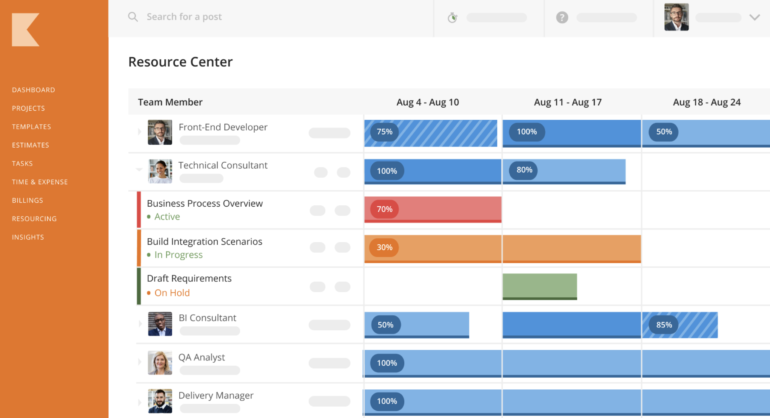
Pricing
Kantata does not publicly disclose the pricing information for its software; you must contact the sales team to get a custom quote.
Standout features
- Resources scheduling and management: See real-time project data and schedule employees to maximize revenue, margins and project timelines.
- Resource capacity planning: Access skills data to match projects to employees’ experience and workload capacity.
- Financial management: Track time, expenses and costs across clients and projects to keep them on deadline and on budget.
Top integrations
- Sage.
- Google Workspace.
- Quickbooks.
- Jira Software.
- Xero.
- Slack.
- Netsuite.
Pros
- Business intelligence and forecasting capabilities included.
- Offers 24/7 support.
- Especially well-suited for agencies and client-facing businesses.
- Time tracking promotes accurate and transparent billing.
Cons
- Pricing is not transparent.
- Number of features can overwhelm some users.
- Higher learning curve.
Why we chose Kantata
Kantata offers an excellent selection of resource management apps — not just project scheduling, but also resource capacity planning, resource forecasting tools, skills analysis and more. Its additional features, such as project management and financial management, make it an all-in-one tool for businesses seeking a lot of functionality.
Bitrix24: Best for small businesses
Bitrix24 is a project and resource management software platform for businesses of all sizes. It has a unique pricing structure where it charges a flat fee for a certain number of users each month, which makes it a useful option for small businesses who don’t want to hassle with adding every single new hire. In addition to effective resource management tools (Figure D), Bitrix24 also provides a range of communication features to promote digital collaboration, including video conferencing, instant messaging and document sharing.
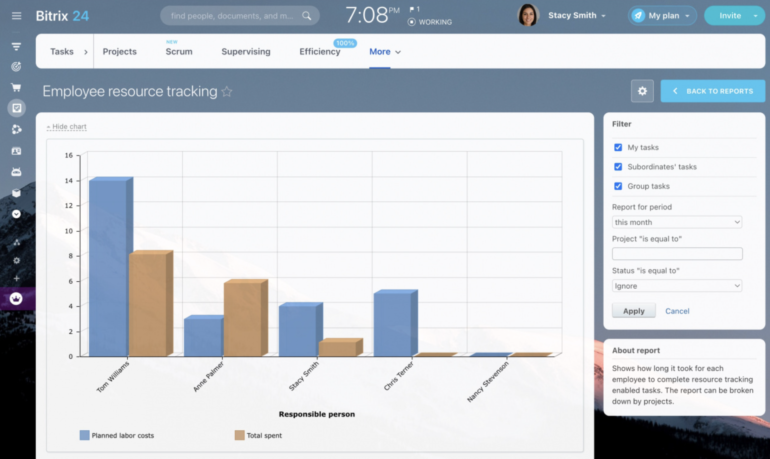
Pricing
- Free plan: Unlimited users with up to 24 GB of storage.
- Basic plan for up to five users: $49 per month for all users billed annually; or $61 per month for all users, billed monthly.
- Standard plan for up to 50 users: $99 per month for all users billed annually; or $124 per month for all users billed monthly.
- Professional plan for up to 100 users: $199 per month for all users billed annually; or $249 per month for all users, billed monthly.
- Enterprise plan starting at 250 users: starts at $399 per month for all users billed annually; or $499 per month for all users billed monthly. Prices increase as you add more employees.
Standout features
- Video conferencing: Bitrix24 supports video conferencing for up to 48 users, so that you don’t have to switch to Zoom if you need to have a call.
- CRM: Bitrix24 comes with a CRM system that helps your business acquire leads, manage contacts and transactions and automate workflows.
- Time management: Bitrix24 offers an absence chart, virtual presence indicator, shift scheduling and task time tracking.
Top integrations
- Google Drive.
- Microsoft Outlook.
- Dropbox.
- Box.
- Xero.
- Mailchimp.
- Docusign.
Pros
- Chats and video calls with task participants.
- Observer and participant roles.
- Templates with subtasks.
- Automatic duplicate detection.
Cons
- Limited support for free and basic plans.
- Manual task time tracking.
- Software can glitch sometimes.
Why we chose Bitrix24
Bitrix25 comes with more than 35 tools to help small businesses optimize their work, including a CRM and resource management. Its pricing structure also takes the guesswork out and means that costs won’t be fluctuating every single month.
Hub Planner: Best for distributed and WFH teams
Hub Planner’s resource management app helps businesses manage their available resources, schedule projects and track time on one centralized platform. With Hub Planner, you can view instant availability insights and filter teams by utilization to allocate resources (Figure E). You can also track billable vs. non-billable hours and estimated time spend vs. actual time spend to use your time more efficiently in the future.

Pricing
- Plug & Play: $7 per resource per month, billed annually.
- Premium: $18 per resource per month, billed annually.
- Business Leader: $54 per resource per month, billed annually.
Standout features
- Resource scheduling: With Hub Planner, users can plan, forecast and schedule teams with its resource scheduler.
- Skills matching: Managers can find team members based on skills and custom characteristics.
- Enterprise reporting: Users can create detailed and comprehensive reports using this advanced feature.
Top integrations
- Zapier.
- Slack.
- Microsoft Teams.
- Okta.
- Basecamp.
- Google Calendar.
- OneLogin.
Pros
- 24/7 support available on higher tier plans,
- Comprehensive feature set.
- Timesheets are easy to use.
- Resource capacity planning and forecasting.
Cons
- Plug & Play plan lacks 24/7 support.
- Limited customization capability.
- Could use more project management features.
Why we chase Hub Planner
Hub Planner’s resource forecasting tools makes it an excellent choice for remote teams and distributed teams. Its enterprise-level reporting features will also be appreciated by businesses seeking to deep dive into their resource management data.
Float: Best for agencies
Float is a cloud-based project and resource management software designed to help teams, agencies and studios manage their projects, resources and budgets. Its colorful, visually appealing interface makes it easy to see workloads at a glance, reallocate resources as needed and create a schedule (Figure F). The budgeting and planning tools ensure that you stay within the client’s parameters, while the time tracking helps your team meet deadlines.
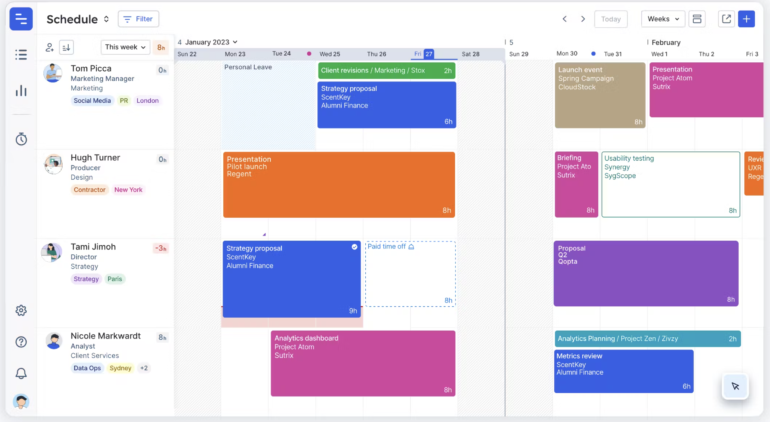
Pricing
- Starter: $6 per user per month, billed annually; or $7.50 per user, billed monthly.
- Pro: $10 per user per month, billed annually; or $12.50 per user, billed monthly.
- Enterprise: custom pricing and best for large teams that want dedicated support.
Standout features
- Time tracking capabilities: Users can prefill timesheets based on scheduled tasks, compare estimated versus actual hours and invoice based on hours worked.
- Scheduling: Managers can create schedules, allocate available resources and manage access roles.
- Resource capacity management: Float enables users to see who is already busy with tasks and assign tasks to the appropriate team member.
Top integrations
- Outlook.
- Google Calendar.
- Slack.
- Asana.
- Jira.
- Trello.
- Teamwork.
- Zapier.
Pros
- Great scheduling tools.
- Very easy to use.
- All plans include 24-hour support.
- Drag and drop schedule view.
Cons
- Could use more native integrations.
- Mobile app could be improved.
- Must upgrade to Pro plan for time tracking.
Why we chose Float
Float offers many tools that are helpful for agencies, specifically scheduling and time tracking tools. However, teams of all kinds will appreciate its workload allocation features and resource tracking tools, as well as its colorful, visual interface.
ClickUp: Best for enterprises
ClickUp is a cloud-based project management software that also includes resource management capabilities. You can quickly visualize digital company assets by using the list (Figure G), table or timeline view, or switch to the workload or box views to dig deeper into workload capacity. Time can be tracked via web browser or the desktop and mobile apps; you can also add manual entries and eset estimates for tasks. Collect vendor and pricing information to calculate costs, usage, downtime and other metrics.

Pricing
- Free: Includes 100MB of storage.
- Unlimited: $7 per person per month, billed annually; or $10 per person, billed monthly.
- Business: $12 per person per month, billed annually; or $19 per person, billed monthly.
- Enterprise: Custom pricing.
Standout features
- Customizable workflow: Select an existing template or build your own custom workflow to manage assets, inventory, office space, business equipment and team tasks.
- Monitor performance: Choose from over 50 widgets to monitor real-time performance data, or combine several for a more comprehensive overview of metrics.
- Template library: Browse templates for managing various resource types, including inventory, facility management, asset management, office space management, invoicing and facilities requests.
Top integrations
- Bitbucket.
- Figma.
- Jira.
- Zapier.
- Google.
- Outlook.
- Slack.
- Calendly.
Pros
- Color, user-friendly interface.
- Automation capabilities.
- iOS and Android apps.
- Native time tracking.
Cons
- Some infrequent glitches reported.
- Only 100MG of storage for the free plan.
- Must upgrade to Enterprise plan to get customer user roles and permissions.
Why we chose ClickUp
ClickUp’s friendly, colorful interface belies its advanced project management and resource management tools. Its forever free plan will appeal to solopreneurs and small businesses, while its more expensive plans will satisfy enterprise needs.
For more information, read the full ClickUp review.
Smartsheet: Best for workflow automation
Resource Management is an add-on to Smartsheet’s core project management plans, and the software recently added workload tracking features to the Business and Enterprise plans as well. This cloud-based resource planning and scheduling tool helps organizations maximize their available resources and optimize their processes (Figure H). The software provides actionable insights on resource availability, task dependencies, resource capacity and performance, enabling managers to make better resource allocation decisions.
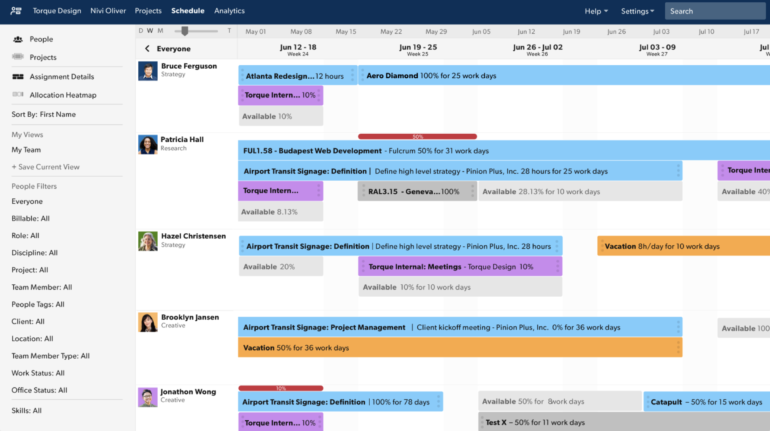
Pricing
- Free: Allows one user and two editors for your team.
- Pro: $7 per user per month, billed annually; or $9 per user, billed monthly.
- Business: $25 per user per month, billed annually; or $32 per user, billed monthly.
- Enterprise: Custom quotes.
Standout features
- Forecasting: Predict staffing shortages and address skill gaps to help your company make strategic hiring decisions before crunch time hits.
- Time tracking: Use the web browser and/or mobile app to track planned time vs. actual time.
- Utilization reporting: See historical data to spot trends, real-time analytics to visualize performance across the project portfolio, build and share custom reports and forecast business growth.
Top integrations
- Slack.
- Microsoft Teams.
- Webex.
- Power BI.
- Adobe Creative Cloud.
- Tableau.
- Okta.
- Jira.
Pros
- Excellent data protection and compliance tools.
- Powerful analytics and reporting.
- Detailed dashboards.
- Great automation features.
Cons
- No kanban views.
- Time tracking limited to Resource Management add-on.
- Steep learning curve for users not familiar with spreadsheets.
Why we chose Smartsheet
Smartsheet paired a traditional spreadsheet-style interface with complex project portfolio management and resource management apps. It offers workflows and automations, powerful analytics and excellent security features to keep your data safe.
For more information, read the full Smartsheet review.
monday work management: Best for flexibility and customization
Built for project managers, monday work management helps teams coordinate and collaborate on projects from start to finish. It offers numerous features to support resource planning, such as the ability to set different priority levels for different tasks (Figure I), creating time estimations before a project kicks off and re-allocating physical resources. Monday work management also comes with a dedicated workload view that lets you see which team members are over or under capacity at a glance.
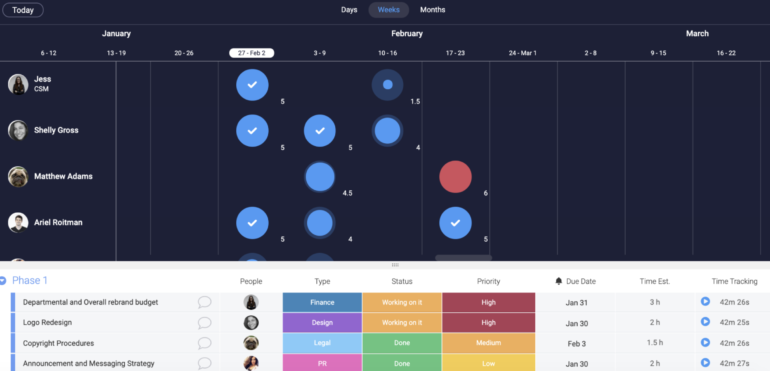
Pricing
- Free: Allows up to two seats.
- Basic: $9 per seat per month, billed annually, or $12 per seat billed monthly.
- Standard: $12 per seat per month, billed annually, or $14 per seat billed monthly.
- Pro: $19 per seat per month, billed annually, or $24 per seat billed monthly.
- Enterprise: Contact the sales team for a quote.
Standout features
- Single sign-on: monday work management offers SSO authentication with Okta, One login, Azure AD and Custom SAML.
- Drag and drop: monday work management has a drag-and-drop interface for efficient portfolio project management.
- Customizable views: Add widgets to your pages or dashboard so you can keep an eye on project progress at all times.
Top integrations
- Slack.
- Google Calendar.
- Jira.
- GitHub.
- Google Drive.
- Trello.
- Dropbox.
- Typeform.
Pros
- No-code automation builder.
- Built-in time tracking on both desktop and mobile.
- Unlimited documents for all plans.
- Includes over 200 templates.
Cons
- The free trial is limited to 14 days.
- Time tracking is only available in high-tier plans.
- Primarily designed for project management, not resource management.
Why we chose monday work management
Monday work management is a very customizable and flexible platform, allowing you to tailor it to your resource planning software needs. It also offers five pricing plans to choose from, making it a highly scalable option that can grow with your business over time.
For more information, read the full monday.com review.
Wrike: Best for midsize to large enterprise
Wrike is a portfolio project management tool that includes resource management capabilities. With Wrike, you can manage team members, track availability and allocate available resources to tasks and projects. View your team’s workload and availability all on one page (Figure J), then use the drag-and-drop interface to manage resource planning and allocations. Users can also set priorities for tasks and projects to ensure that the most important work gets done first.
Figure J: The workload view in Wrike. Image: Wrike
Pricing
- Free: No cost.
- Team: $9.80 per user per month for two to 25 users.
- Business: $24.80 per user per month for five to 200 users.
- Enterprise: Custom quote.
- Pinnacle: Custom quote.
Standout features
- Accelerated resource planning: This feature helps managers estimate the resources needed for a project and provides visibility into resource allocation.
- Resource forecast: Anticipate hiring needs and capacity demand by leveraging Wrike’s visibility into future job roles and capacity demand.
- Budget management: Monitor spending in real time to keep your projects on budget.
Top integrations
- Google Drive.
- Zoom.
- Miro.
- Microsoft OneDrive.
- Tableau.
- Slack.
- Dropbox.
Pros
- Time tracking capabilities.
- Kanban board for task management.
- Five pricing plans to choose from.
- Forever free plan.
Cons
- Advanced security features are only available in Enterprise and Pinnacle plans.
- Folder-based interface can be confusing.
- Primarily designed for project management, not resource management.
Why we chose Wrike
Wrike’s advanced project portfolio management tool and resource planner software make it an excellent choice for medium and large enterprises. It also provides a forever free plan with limited features so that small businesses on a budget can still use it as well.
For more information, read the full Wrike review.
What are the key features of resource management software?
When shopping for your organization’s best resource management software, look for the following features:
Resource allocation
Your chosen resource planner software should be able to allocate available resources to various projects or tasks based on their availability and skill sets. This can include managing staff, equipment and other resources.
Capacity planning
The resource tracking software should be capable of planning and forecasting the capacity of resources, ensuring teams have enough resources to meet the demands of their projects.
Time tracking
The resource management app should allow teams to track planned time versus actual hours spent on tasks and resource usage. This can help managers identify areas where available resources could be better utilized.
Task scheduling and tracking
The resource tracking tool should be able to automatically assign tasks to the right people and track progress to ensure tasks are completed on time.
Reporting and analytics
The best resource management software should provide users with real-time data and analytics on resource utilization, project progress and other key performance indicators.
How to choose resource management software
The best resource management software for your company depends on your needs and preferences. Start your search by defining your organization’s resource management needs. This includes the types of resources you need to manage, the level of complexity of your resource allocation process and any specific features or functionalities you require. Resource management involves handling sensitive data, so you should also prioritize project and resource management software with robust security features.
Next, research different resource management software options and compare their features, functionalities and pricing. Consider factors like ease of use, customization options and customer support when comparing resource forecasting tools to each other. Keep in mind that your resource management needs will likely change as your organization grows, so make sure that the pricing plans offer the scalability that you need in the future.
Once you have your short list of potential resource management apps, confirm that each platform is compatible with your existing systems and workflows and integrates well with your other tools. Request demos and trials of the resource planner software you’re considering to get a feel for its features, functionalities and user interface. This can help you make an informed decision before committing to a resource tracking tool.
Review methodology
We evaluated hundreds of available software solutions to determine the best resource management software in 2024. We looked at the features, pricing, customer reviews, ease of use, scalability and overall customer satisfaction. We also considered the opinions of industry leaders and customer feedback. We then identified the top-rated solutions and narrowed them down to the 10 best resource management software solutions.













